Mark Levinson No512 (£12,000)
Odd timing, you may think. As SACD and DVD-A celebrate – if that’s the word – a decade of underachievement as CD’s putative successor(s), with DVD-A now moribund and SACD reduced to the status of a niche music carrier, Mark Levinson releases its first CD/SACD player. Not a universal player, note – the No512 has no truck with music on DVD-V or DVD-A, let alone BD – nor even one able to unlock the full potential of multichannel SACDs, since it is stereo only. Ironically, Mark Levinson the man, as opposed to Mark Levinson the company (with which he has had no association for many years), has long been a vocal advocate of SACD, but only now does a product bearing his name support the format that, in the interim, has become a cul-de-sac in audio’s tree of life.
IT OUGHT TO BE GOOD
With this limited remit, and at this high price, the No512 had better be a stonker. Aesthetically it gets off to just the right start. I’ve always admired ML’s understated approach to styling. There’s nothing flashy, nothing garish, nothing to titillate the nouveau riche here: just a simple but classy black anodised fascia with dimpled silver-grey push-buttons, a red dot-matrix display and a line of discreet red indicator LEDs beneath. Ergonomically it’s no exemplar since all the transport buttons are the same size and shape, and are identified only by words unsupported by symbols. But you quickly learn your way around. The thin metal disc tray was the only item that slightly let the side down in the review sample, sporadically graunching a little when opening or closing. An isolated indiscretion, I’m sure.
You’d expect a product of this class to offer both unbalanced and balanced outputs, which the No512 does. Moreover, it incorporates a volume control – analogue, not digital – which allows direct connection to a power amplifier if desired. Fixed output voltage is also available, with selection of either mode via the remote control. Inadvertent switching between the two – which might involve a nasty shock to the listener at least, and speaker damage at worst – is prevented by the need for a sustained press on the appropriate key. And if fixed output level is selected, an LED lights on the facia, giving visual warning.
Now that I’ve mentioned the remote, it is – arguably – the one example of excess about the No512. Of course you’d expect, and get, a metal-bodied handset rather than a flimsy plastic item, and you’ll welcome its clear layout and the fact that it is spacious enough to accommodate podgy fingers – although perhaps not the fact that its keys don’t illuminate. But it is too wide to fit comfortably in the hand, particularly if that hand is female; and did it really have to weigh 390g? Don’t drop it on your glass-topped coffee table!
In operation the No512 is slick and fast, without the protracted disc ident delay of a universal player. From pressing the ‘drawer’ button to close the disc tray to the disc being ready to start takes about 15 seconds. Switching between CD and SACD layers of a hybrid disc takes five seconds. Unless you’re in a tearing hurry, neither delay is of annoying proportions.
Rear panel connections include balanced and unbalanced outputs, both digital and analogue, as you’d expect. Less familiar is a connector zone labelled ‘Control’ which comprises an IR input, trigger input and output, an RS-232 control port and ethernet port. These are provided for use within installed systems, the ethernet port offering control via ML’s Net software.
TRYING SOME ALTERNATIVES
If I remember rightly the last SACD player I had on review was the transcendent multichannel combination, which I was fortunate enough to spend a few weeks with all of four and a bit years ago. Since then I have continued to buy SACDs but have only listened to the hybrid discs’ CD layers, so my first task with the No512 was to sit down and work through a pile of old and new discs to decide what to use for the listening. For some reason this seems to be particularly important with SACDs, some of which – including ones recommended by people who ought to know better – are bedevilled by a cloying cloudiness of sound that I was near to thinking endemic to the medium in its early years. Onto my scrap pile went, for instance, my Midori Mozart, Wispelwey Tchaikovsky and Telarc’s Britten/Elgar – all tediously turgid. But another, more virtuous pile grew alongside.
Actually, I lie: this wasn’t quite the first thing I did with the No512. Noting that it is supplied with a thicker than typical mains cable, I had initially experimented with substituting an expensive upmarket alternative: a 1.5m length of Siltech Ruby Hill. And I was very glad I did because it wrought a remarkable improvement. T Minus 5’s Purity SACD was used for the comparison, specifically the track ‘Shenandoah’. A little of this style of
a cappella singing goes a long way with me, frankly, but the IsoMike recording is remarkable for its natural spaciousness and vocal timbres, both of which were convincingly better rendered with the Siltech cable – which I duly used for the remainder of the listening.
SWEDE SOUNDS
Having sorted out desirable discs and tweaked the mains cable, the next task was to assess the No512’s integral volume control. Would I prefer it to my DIY multichannel passive preamp built around an eight-gang DACT stepped attenuator, and hooked up internally with the same company’s precious metal wiring? The No512’s internal volume control ought to win, if only on the basis that it eliminates a pair of cables – but the DACT device is very transparent and tough to beat. As indeed it proved, because on a straight comparison using unbalanced connection to a Bryston 4B power amplifier, I marginally preferred the external volume control.
For this comparison I chose the first few tracks of Opus 3’s Showcase 2005 SACD, on the basis that the Swedish label has, in my experience, produced some of the best sonic results using DSD recording. With the external volume control the filigree percussion that opens ‘Vaquero’ was a little better resolved, while ‘The Talk Of The Town’ simply ebbed and flowed a little better. But the preference was reversed when I used the No512’s internal volume control via balanced connection to the Bryston, in significant part, I suspect, because of the costly Siltech Compass Lake interconnect cables I used (the unbalanced connection was via Chord Company Chameleon Silver Plus). Moral of the story: this is fertile ground for individual experimentation, since the results will certainly be cable, external volume control and rest of system dependent.
One last comparison was required before I could simply sit back and enjoy the No512 making music: a quick tête-à-tête with the only other SACD player I had to hand, Sony’s well regarded – but very much cheaper – XA5400ES. I won’t dwell on this obvious bantamweight versus heavyweight mismatch save to say that, compared using unbalanced connection via my passive preamp, the No512 ground its heel into the aspirant’s upturned face. Law of diminishing returns? Piffle. Whoever coined that phrase didn’t know high-end audio.
Duty done, I settled down to sampling the insights that the No512 offers into other superior items from the SACD catalogue. One of the recently acquired discs I was looking forward to hearing for the first time from the SACD layer was Elton John’s Elton John [Island B0003607-36], which formed a key part of the soundtrack of my youth.
Instinctively I always go straight to track six and the remarkable ‘Sixty Years On’ – a piece which reliably dumbfounds people familiar only with the crooner incarnation of EJ. But I listened to the other original tracks too, of which ‘First Episode At Hienton’ and ‘The King Must Die’ seem to fare particularly well. This may well be as good as this 1970 recording is ever going to sound, the No512 mining fresh nuances while at the same time rendering the whole sound more spacious, more effortlessly natural. I’m still no nearer to knowing whether the surround mix will entrance or infuriate me, though.
PentaTone’s Classics series provides a fascinating insight into what 1970s quadraphonics might have delivered had the technology existed to carry an accurate facsimile of the master tape into people’s homes. Although the surround experience is beyond the No512’s power to deliver, the stereo SACD layers make for fine listening too. One of my favourites from the series is the first volume of Handel organ concertos, played by Daniel Chorzempa and Concerto Amsterdam under Jaap Schröder [PTC 5186 103]. Once again the No512 delivered exquisite detail but without ever throwing it in your face. Above all, the sound was effortlessly spacious and refined, in the way that turns short listening sessions into long ones.
I’ve mentioned Hilary Hahn’s fine recording of Vaughan Williams’ The Lark Ascending [DG 474 8732] a few times recently, but again this was the first time I’d had the opportunity to hear the SACD layer. It didn’t disappoint. As Hahn’s violin swooped and soared above the sometimes sparse, sometimes lush orchestral accompaniment, it struck me how privileged we are as a generation to be able to experience reproduced sound of this quality – and how ironic it is that, afforded this unprecedented opportunity, the music buying public allowed SACD and DVD-A to wither on the vine. What was it Oscar Wilde said about knowing the price of everything and the value of nothing?
AS ADEPT WITH CD
Of course, I also took the opportunity with hybrid discs to switch to the CD layer and I played plain vanilla CDs as well. No question, the No512 excels with the original optical disc medium too. Imaging is precise and rock-steady and, as it does with SACD, the ML is adept at revealing telling detail without sounding soulless in the way that CD easily can. Yes, SACD is even better – but that’s the medium rather than the machine.
What I wish I could tell you but can’t is how the No512 stacks up against other top-flight SACD players. My experience of the EMM Labs CDSD/DAC6e is too remote for me to say anything more than that the two are clearly in the same ballpark. Too much water has flowed under the bridge in the interim for me to be more specific, and in any case Ed Meitner’s masterpiece amazed me principally because of its eye-popping performance on multichannel material. And how the No512 would fare against dCS’s Scarlatti system is an unknown as I’ve heard only elements of it. As it says in the textbooks, this is an exercise for the reader (if in the market for the very finest in SACD replay).
So, Mark Levinson’s first SACD player may have been late arriving, but it delivers. Now, Harman, please can we have a surround version – before it’s too late?
VERDICT
Mark Levinson’s promotional material talks of the No512’s ‘breathtaking transparency’, and that’s no idle claim. Whereas lesser SACD players can be ‘analogue’ sounding to a fault, the No512 – on the better SACDs – strips away the softened, homogenised sound so often heard from DSD to reveal its true blend of subtle detail, spacious imaging and vivid tone colours. And it’s cracking as a CD player.
Sound Quality: 87%
Originally published in the February 2010 issue




























































